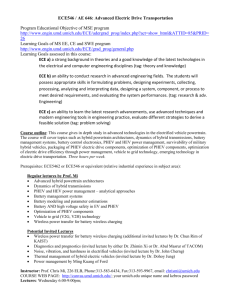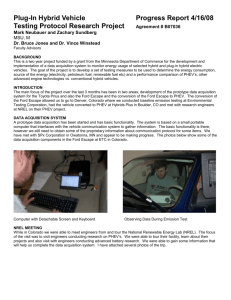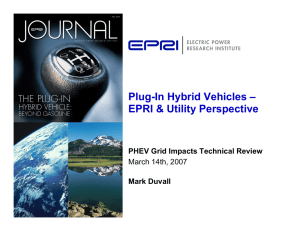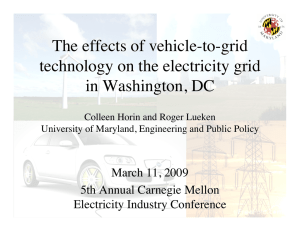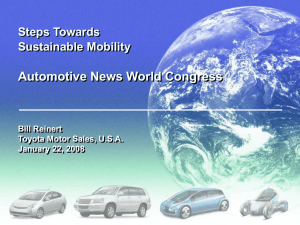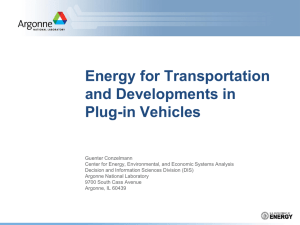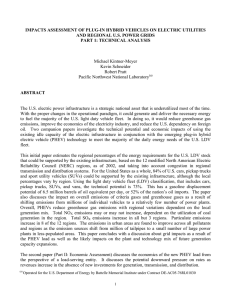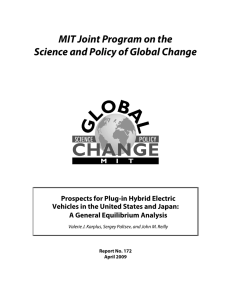Plug-In Hybrid-Electric Vehicles Current Status, Long
advertisement
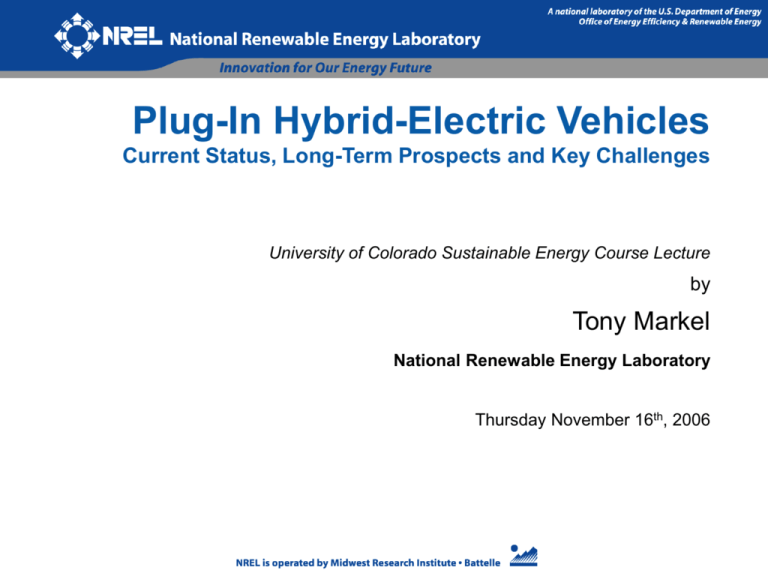
Plug-In Hybrid-Electric Vehicles Current Status, Long-Term Prospects and Key Challenges University of Colorado Sustainable Energy Course Lecture by Tony Markel National Renewable Energy Laboratory Thursday November 16th, 2006 Overview • Why plug-in? • What is a Plug-In Hybrid-Electric Vehicle (PHEV)? • State-of-the-art in PHEV technology and key players in the industry • Key challenges in bringing viable PHEVs to market • NREL’s contributions to PHEV research and development Why Plug-In Hybrids? The Perfect Storm • World oil production predicted to peak within the next 5-15 years • Recent increase in gasoline price is indicator of growing tension between supply and demand Domestic Production Domestic Consumption 20 Petroleum (mmb/day) • Petroleum consumption has steadily increased while domestic production has continued to decline 25 15 10 5 Source: U.S. Department of Energy, Energy Information Administration 0 1940 1950 1960 1970 1980 1990 2000 2010 Gasoline price - 200% rise in 8 years! Weekly National Average Gasoline Price ($/gallon) $3.50 $3.00 $2.50 $2.00 Source: Hubbert Center Newsletter #99/1 R. Udall and S. Andrews $1.50 WHAT’S OUR PLAN? $1.00 $0.50 Source: US Dept of Energy, Energy Information Administration $1990 1993 1995 1998 2001 2004 2006 America’s Oil Addiction • Transportation sector nearly 100% petroleum dependent • Transportation accounts for two-thirds of total petroleum consumption “America is addicted to oil…” • 58% of petroleum is imported The President’s Advanced Energy Initiative Goals: Fueling Our Vehicles 1. Develop advanced battery technologies that allow a plug-in hybrid-electric vehicle to have a 40-mile range operating solely on battery charge 2. Foster the breakthrough technologies needed to make cellulosic ethanol costcompetitive with corn-based ethanol by 2012. 3. Accelerate progress towards the President’s goal of enabling large numbers of Americans to choose hydrogen fuel cell vehicles by 2020. Source: www.whitehouse.gov Oil Use Reduction with HEVs Light Duty Fleet Oil Use - Impact of HEVs on Consumption 16 2005 AEO Base Case HEV Scenario 14 Oil Consumption (MPBD) 12 Oil use same as today! 3 MBPD 10 8 6 4 This highly aggressive scenario assumes 100% HEV sales from 2010 onwards… 2 0 2000 2005 2010 2015 2020 2025 2030 Year HEVs unable to reduce consumption below today’s consumption level Produced using VISION model, MBPD = million barrels per day Oil Use Reduction with PHEVs Light Duty Fleet Oil Use - Impact of PHEVs on Consumption 16 2005 AEO Base Case PHEV Scenario 14 Oil Consumption (MPBD) 12 Oil use reduction! 4 MBPD 10 8 6 PHEVs on E85 ?? 4 This highly aggressive scenario assumes 100% HEV sales from 2010 and 50% PHEV40 sales from 2020 onwards… 2 0 2000 2005 2010 2015 2020 2025 2030 Year PHEVs reduce oil consumption with a transition to electricity Produced using VISION model, MBPD = million barrels per day What is a Plug-In Hybrid-Electric Vehicle (PHEV)? Contemporary Hybrids Toyota Camry Honda Civic Saturn Vue Toyota Prius Honda Accord Ford Escape Toyota Highlander Lexus RX400h Honda Insight Lexus GS450h Chevy Silverado A “Full” Hybrid ADVANCED ENGINE ELECTRIC ACCESSORIES ENGINE DOWNSIZING PETROLEUM ONLY REGENERATIVE BRAKING 76hp gasoline engine, 67hp electric motor, 1.5kWh battery ENGINE IDLE-OFF A Plug-In Hybrid ADVANCED ENGINE Fuel Flexibility ELECTRIC ACCESSORIES ENGINE DOWNSIZING PETROLEUM AND/OR ELECTRICITY ENGINE IDLE-OFF REGENERATIVE BRAKING BATTERY RECHARGE 76hp gasoline engine, 67hp electric motor, 9.0kWh battery (30mi) Benefits of a Plug-In vs. Full Hybrid CONSUMER BENEFITS Lower “fuel” costs Fewer fill-ups Home recharging convenience By plugging it in… Less CO2 emissions Less air pollution Less petroleum use NATIONAL BENEFITS Fuel flexibility Vehicle-to-grid (V2G) potential Better Energy utilization of diversity generation capacity Plug-In Hybrid Variants - Midsize Sedan HEV Conventional 164hp 103hp 47hp / 1.3kWh 3150 lbs 3070 lbs 3460 lbs 3240 lbs PHEV40 110hp 60hp / 16.1kWh PHEV20 106hp Note: these are hypothetical vehicles with equivalent 0-60mph performance 59hp / 7.7kWh Plug-In Hybrid Fuel Economy Predicted fuel economy and operating costs for midsize sedan1 Vehicle Type Gasoline Fuel Economy Electricity Use Annual Energy Use Annual Energy Cost Recharge Time3 Conventional 27 mpg --- 564 gal. $1360 --- Hybrid-Electric 36 mpg --- 416 gal. $1000 --- Plug-In Hybrid 20mi range 51 mpg 0.09 kWh/mi 297 gal. and 1394 kWh2 $716 + $125 < 4 hrs Plug-In Hybrid 40mi range 69 mpg 0.16 kWh/mi 218 gal. and 2342 kWh2 $525 + $211 < 8 hrs 1) 2) 3) Assumes 15,000 miles annually, gasoline price of $2.41 per gallon, electricity price of 9c/kWh Note that average US household consumes 10,700 kWh of electricity each year Using 110V, 20A household outlet PHEVs Reduce Fuel Consumption By >50% On Real- World Driving Cycles 227 vehicles from St. Louis each modeled as a conventional, hybrid and PHEV 35 400 Conventional Hybrid PHEV20 PHEV40 26 mpg 350 30 25 20 300 37 mpg • 8647 total miles driven • 100% replacement of sample fleet 58 mpg & 140 Wh/mi 250 200 15 150 10 100 76 mpg & 211 Wh/mi 5 0 0 5 10 15 Time of Day (hr) 20 25 50 0 30 Average Daily Costs Cumulative Fuel Consumed (gallons) Percentage of Vehicle Fleet In Use (%) 40 Gas. Elec. ¢/mi CV $3.45 --- 9.1 HEV $2.48 --- 6.5 PHEV20 $1.58 $0.48 5.4 PHEV40 $1.21 $0.72 5.1 Assumes $2.41/gal and 9¢/kWh PHEVs: >40% reduction in operating costs >$500 annual savings HEVs and PHEVs Likely to Reduce Greenhouse Emissions Source: Hybrid Electric Vehicle Working Group, www.epri.com Electrified Miles May Lead to Cleaner Operation Source: Hybrid Electric Vehicle Working Group, www.epri.com PHEV Impact on Utilities Load (% of Annual Peak Load) 1 0.9 0.8 0.7 0.6 0.5 0.4 0.3 Summer Maximum 0.2 Winter 0.1 Spring Minimum 0 0 24 48 72 96 120 144 Hour Typical Hourly Electric Demand Patterns 168 PHEV Impact on Utilities Utility Sized for Annual Peak 700 650 600 Peak Shaving? 550 Load (MW) No PHEVs w/PHEVs Excess Capacity 500 450 Night-time charging of PHEV’s 400 350 Ratio of base to peak is measure of utility performance 300 250 200 0 2000 4000 6000 Hour Hours at Load Annually Assumes utility controlled night-time charging for 50% of the vehicles in this utility district 8000 State-of-the-Art in PHEV Technology and Key Players in the Industry OEM Plug-In Hybrids 2003 Renault Kangoo Elect’road - up to 50mi electric range - approximately 500 sold in Europe DaimlerChrysler Sprinter PHEV - 15 prototypes being produced for testing in various locations in Europe and North America - up to 20mi electric range DaimlerChrysler Sprinter PHEV OEM Plug-In Hybrids “…Toyota executive Shinichi Abe has been quoted…that Toyota is working on plug-in hybrids…that the next-generation Prius will have an all-electric range of about nine miles…” Green Car Congress, 23 April 2006 “…we are looking at plug-in hybrids…we are very keenly looking at it, and working with that technology.” Bill Ford Jr, 11 May 2006 Other PHEV Prototypes - Industry EnergyCS Plug-In Prius HyMotion Escape PHEV AC Propulsion Jetta PHEV AFS Trinity Extreme Hybrid™ Esoro AG H301 Other PHEV Prototypes - Universities University of California, Davis University of Queensland, Australia San Diego State University PHEV Batteries Johnson Controls / SAFT Valence Technologies Cobasys Hymotion PHEV Supporters Founding Partners — — — — — — — — Austin Energy City of Austin, Texas City of New York Set America Free Coalition Center for Energy and Climate Solutions Center for National Security Policy American Public Power Association Plus several hundred other cities and counties, utilities, national security and environmental groups www.pluginpartners.org PHEV Supporters cont. Membership as of March 2006 — Pacific Gas & Electric (utility) — Southern California Edison (utility) — Raser Technologies (drives) — Maxwell Technologies (ultracaps) — Electrovaya (lithium batteries) — Enax (lithium batteries) — Daiken (lithium batteries) — International Battery (lithium batteries) — A123Systems (lithium batteries) — Delta-Q Technologies (power electronics) www.hybridconsortium.org PHEV Supporters cont. • Electric Power Research Institute (EPRI) • California Cars Initiative • Plug-In America • Americans for Energy Independence • Senator Orrin Hatch (R), Utah • President George W. Bush Key challenges in bringing viable PHEVs to market Battery Life • PHEV battery likely to deep-cycle each day driven: 15 yrs equates to 4000-5000 deep cycles • Also need to consider combination of high and low frequency cycling 70% 50% 4000 Data presented by Christian Rosenkranz (Johnson Controls) at EVS 20 Battery Packaging Vehicle Costs Projected Retail Powertrain Costs - Midsize Sedans 1) including manufacturer and dealer markups 2) all component costs assume projected status $18,000 $16,000 $14,000 $663 charger/plug battery motor/inverter transmission engine $663 $12,000 $8,433 $10,000 $5,117 $8,000 $2,433 $6,000 $2,079 $2,407 $2,454 $1,992 $2,004 $2,020 $2,865 $2,919 $3,002 HEV PHEV20 PHEV40 $1,998 $4,000 $2,000 $4,005 $CV Vehicle Costs cont. Cumulative Vehicle plus Energy (Fuel/Elec.) Costs $60,000 CV HEV PHEV20 PHEV40 Cumulative cost (2006 $) $50,000 $40,000 $30,000 $2.41/gal. (today) $3.00/gal. $4.00/gal. (2005 avg) $20,000 $10,000 $0 5 10 Time after purchase (years) 15 Vehicle Costs cont. Why would PHEV buyers pay more? 1. Tax incentives 2. Reduced petroleum use, air pollution and CO2 3. National energy security 4. Less maintenance 5. Reduced fill-ups 6. Convenience of home recharging (off-peak) 7. Improved acceleration (high torque of electric motors) 8. Green image, “feel-good factor” Summary 1. PHEVs are a key technology in the portfolio of options to reduce US oil use 2. They also provide significant other consumer and national benefits 3. Precommerical PHEV prototypes are on the road today 4. There has been a surge in community, industry and political support for PHEVs 5. The key remaining barriers to commercial PHEVs are battery life, packaging and cost Summary of NREL PHEV Activities • National benefits assessment – oil use and greenhouse emissions • Vehicle-Level — — — — PHEV systems modeling and design tradeoffs analysis Battery characterization testing and engineering Developing procedures for PHEV testing and MPG reporting Evaluating real-world use and performance of PHEVs • Utility Level — Assessment of PHEV impacts on utilities — Exploring synergies between PHEVs and renewables — V2G opportunities for PHEVs in regulation services • Advisors to DOE and automotive OEMs – working to identify and overcome barriers to PHEV adoption Vision for Transport in Sustainable Communities PHEVs with renewable electricity and biofuels/hydrogen Acknowledgements NREL Center for Transportation Technologies and Systems: • Terry Penney – Manager, FreedomCAR and Vehicle Technologies • Matthew Thornton, Tony Markel, Aaron Brooker, Jeff Gonder – Vehicle Systems Analysis Team • Michael O’Keefe – Advanced Power Electronics Team • Ahmad Pesaran – Energy Storage Team • Jennifer Elling, Theresa von Kuegelgen – Communications Team NREL Energy Analysis Office: • Walter Short, Paul Denholm, Peter Lilienthal Disclaimer and Government License This work has been authored by Midwest Research Institute (MRI) under Contract No. DE-AC36-99GO10337 with the U.S. Department of Energy (the “DOE”). The United States Government (the “Government”) retains and the publisher, by accepting the work for publication, acknowledges that the Government retains a non-exclusive, paid-up, irrevocable, worldwide license to publish or reproduce the published form of this work, or allow others to do so, for Government purposes. Neither MRI, the DOE, the Government, nor any other agency thereof, nor any of their employees, makes any warranty, express or implied, or assumes any liability or responsibility for the accuracy, completeness, or usefulness of any information, apparatus, product, or process disclosed, or represents that its use would not infringe any privately owned rights. Reference herein to any specific commercial product, process, or service by trade name, trademark, manufacturer, or otherwise does not constitute or imply its endorsement, recommendation, or favoring by the Government or any agency thereof. The views and opinions of the authors and/or presenters expressed herein do not necessarily state or reflect those of MRI, the DOE, the Government, or any agency thereof.
